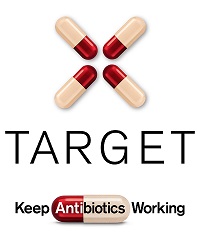Resources for the community pharmacy setting
Completion requirements


We have grouped all of the TARGET resources that are to be used in the community pharmacy setting in one place to make it easier for you to find them all.
Version 1.0, August 2022.
UTI Women Under 65 Leaflet for community pharmacies
UTI pharmacy leaflet HTML

For women under 65 years with suspected lower urinary tract infections (UTIs) or lower recurrent UTIs (cystitis or urethritis)
For community pharmacy
For community pharmacy
Contents
- Possible urinary signs and symptoms
- Outcomes and recommended care
- When should you get help?
- Self-care to help yourself get better more quickly
- Options to help prevent a UTI
- Antibiotic resistance
- About this leaflet
Possible urinary signs and symptoms
Key signs/symptoms
- Dysuria: Burning pain when passing urine (wee)
- New nocturia: Needing to pass urine in the night
- Cloudy urine: Visible cloudy colour when passing urine
Other signs/symptoms to consider
- Frequency: Passing urine more often than usual
- Urgency: Feeling the need to pass urine immediately
- Haematuria: Blood in your urine
- Suprapubic pain: Pain in your lower tummy
Other things to consider
Recent sexual history
- Inflammation due to sexual activity can feel similar to the symptoms of a UTI
- Some sexually transmitted infections (STIs) can have symptoms similar to those of a UTI
Changes during menopause
- Some changes during the menopause can have symptoms similar to those of a UTI
Outcomes and recommended care
When should you get help?
Contact your GP practice or contact NHS
Phone for advice if you are not sure how urgent the symptoms are.
- You have shivering, chills and muscle pain
- You feel confused, or are very drowsy
- You have not passed urine all day
- You are vomiting
- You see blood in your urine
- Your temperature is above 38°C* or less than 36°C
- You have kidney pain in your back just under the ribs
- Your symptoms get worse
- Your symptoms are not starting to improve within 48 hours of taking antibiotics
Self-care to help yourself get better more quickly
- Drink enough fluids to stop you feeling thirsty. Aim to drink 6 to 8 glasses
- Avoid too much alcohol, fizzy drinks or caffeine that can irritate your bladder
- Take paracetamol or ibuprofen at regular intervals for pain relief, if you have had no previous side effects
- There is currently no evidence to support taking cranberry products or cystitis sachets to improve your symptoms
- Consider the risk factors in the ‘Options to help prevent UTI’ section to reduce future UTIs
Options to help prevent a UTI
It may help you to consider these risk factors:
- Stop bacteria spreading from your bowel into your bladder. Wipe from front (vagina) to back (bottom) after using the toilet
- Avoid waiting to pass urine. Pass urine as soon as you need to
- Go for a wee after having sex to flush out any bacteria that may be near the opening to the urethra
- Wash the external vagina area with water before and after sex to wash away any bacteria that may be near the opening to the urethra
- Drink enough fluids to make sure you wee regularly throughout the day, especially during hot weather
If you have a recurrent UTI, the following may help:
- Cranberry products and D-mannose: There is some evidence to say that these work to help prevent recurrent UTI
- After the menopause: Topical hormonal treatment may help; for example, vaginal pessaries
- Antibiotics at night or after sex may be considered
Antibiotic resistance
- Antibiotics can be lifesaving. But antibiotics are not always needed for urinary symptoms
- Antibiotics taken by mouth, for any reason, affect our gut bacteria making some resistant
- This may make future UTI more difficult to treat
- Common side effects to taking antibiotics include thrush, rashes, vomiting and diarrhoea. Seek medical advice if you are worried
- Keep antibiotics working; only take them when advised by a health professional. This way they are more likely to work for a future UTI
About this leaflet
TARGET is operated by the UK Health Security Agency. Developed in collaboration with professional medical bodies.
Version: 1
Published: September 2022
Review: September 2025